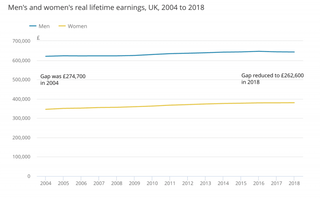
Report: Women Earn Only 59% of What Men Earn Over Their Lifetimes
Significantly, women with Master’s degrees and PhDs earned less than men of the same age with undergraduate level qualifications in the U.K.

Women are paid GB£263,000 less than men, on average, through their lifetimes, according to the latest official figures that illuminate the U.K.’s stubborn gender pay gap.
With the goal to assess Britain’s human capital in financial terms, the Office of National Statistics (ONS) released data that revealed the average female worker’s lifetime earnings are 59% of what the average male takes home: while men earned an average of GB£643,000 throughout their working life, women made only GB£380,000. Compared to 2004, the pay gap has decreased, but only marginally by three percentage points; 15 years ago, women made 56% of men’s lifetime earnings.

Image Credit: ONS
The data also showed that the total number of job seekers in the U.K. with master’s degrees or PhDs now outnumber those with an undergraduate degree or an equivalent; the former group seems to enjoy a pay premium, earning about 10% morethan the latter group. According to the ONS, this boost in salary is more for women with higher degrees than men with the same qualifications.
“For example, among those aged 36 to 45 years, women with a Master’s or PhD degree will earn, on average, GB£108,000 more over the rest of their working life than those with an undergraduate degree, compared with a premium of GB£92,000 for men. This suggests that, in terms of future earnings, it is more beneficial for women to obtain higher degrees than for men,” the ONS said in its report.
Despite this, women with a Master’s or PhD degree still earned on average 33% less through their lifetimes than men, with the same level of qualification. There is a gender pay gap even between women with higher degrees and men with undergraduate qualifications: “Women aged 26 to 35 years with higher degrees have average lifetime earnings of GB£803,000, whereas men of the same age with undergraduate level qualifications have average lifetime earnings of around £1,160,000,” the ONS said.
To arrive at a number for human capital (stock of knowledge, skills, and experience possessed by an employee, viewed in terms of their cost to an organisation/country) , the ONS took the total amount of hours an individual (depending on their age, sex, and highest qualification grouping) is expected to work until the age of 65 and divided it by that individual’s lifetime earnings. Based on this formula, the ONS found that women’s human capital “is 22.7% lower than men’s” and attributed this difference to fewer hours worked by women, with many more of them working part-time than men.
Related on The Swaddle:
Parenthood Sets Women, But Not Men, on a Path of Lower Lifetime Earnings
This circles back to a tale as old as time: burdened with the responsibility of childbirth, child-rearing, and homemaking, women often end up falling behind in the labor market, socially pressured to prioritize family life over having a career. This ensures the gender pay gap remains stubborn as ever (when it comes to deciding which of the two parents in a heterosexual couple stays home or works part-time, with lower hourly wages to raise the kids, it’s almost always the one with the smaller paycheck — a.k.a women). Furthermore, it also dominoes into lower pensions and retirement savings for women.
In India, too, the situation isn’t any different. According to a recent report by Economic Times, the gender pay gap only closed by 1% last year. From earning 20% less than men in 2017, women earned 19% less in 2018. The gender pay gap widened with increasing level of skill: while there was barely any pay gap in semi-skilled work, the gap touched 20% for skilled occupations and 30% for highly skilled occupations — in favor of men. The gap also increased with experience — men with 10 years or more of experience earned 15% more than women with similar work experience. “The narrowing of the gender pay gap by just 1% is not just a cause for concern, but a reminder to genuinely introspect if we are doing enough,” Abhijeet Mukherjee, chief executive officer, Monster.com, APAC & Gulf told the Economic Times. “It becomes pivotal to galvanize forces across corporates and industries to work towards gender pay parity.”
Speaking to The Guardian about the latest ONS data, Gemma Rosenblatt of the Fawcett Society, one of the most vigorous campaigns around the gender pay gap, said: “More needs to be done to tackle the gender pay gap and its causes. Gender pay gap reporting is helpful but it needs to go further. It’s time for action, not excuses. [The] government needs to require employers to publish action plans setting out how they will close their gender pays and monitor progress. There should be meaningful sanctions in place for those who do not comply.
“The cumulative impact of the gender pay gap leaves women with a significantly lower lifetime income and pension pot than men – this simply isn’t fair.”
Pallavi Prasad is The Swaddle's Features Editor. When she isn't fighting for gender justice and being righteous, you can find her dabbling in street and sports photography, reading philosophy, drowning in green tea, and procrastinating on doing the dishes.
Related


Cisgender, Heterosexual Men Tell Us How They Confront Sexism Against Women
